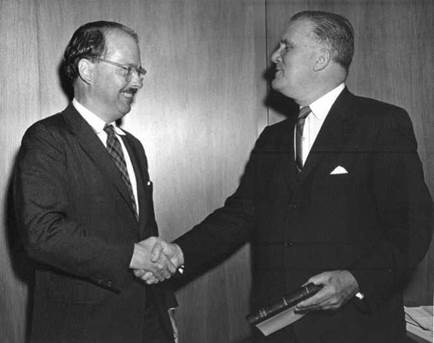Bureau of the Budget Review
After helping prepare the Webb-McNamara report over the May 6-7 weekend, Willis Shapley found himself in charge of carrying out a review of that report from the BOB perspective. The draft of the internal BOB review was completed on May 18, and BOB director Bell sent it to Secretary of Defense McNamara, NASA administrator Webb, and Atomic Energy Commission chairman Glenn Seaborg with a request for immediate comments. Welsh of the Space Council also received a copy in the absence of Vice President Johnson, who was still touring in Asia. The final version of the review was dated May 20.
The review was the kind of thorough “due diligence” assessment that was the BOB’s responsibility, pointing out the implications of the decisions being proposed and examining potential obstacles to their successful implementation. With respect to the magnitude of resources that would be needed, the review pointed out that what was being proposed was an increase of over $2 billion per year—perhaps even $3 billion per year—over previously planned budgets. It recognized that the budget estimates being used were subject to upward revision, suggesting that “the funds required by the manned lunar landing objective may have been underestimated by as much as $200 million in 1962 and perhaps $1 billion per year in future years.” What would be needed was “a commitment to a long term-effort and to provide the resources it requires. Starts and stops, changes in goals, or failure to provide the required level of budgetary support would impair the success of the program.” It noted that “the commitment actually extends beyond the achievement of the manned lunar landing . . . By 1967 we will have geared
|
James Webb with Willis H. Shapley (on left), the Bureau of the Budget staff person who played a key role in space decisions during the Kennedy administration (NASA photo). |
the nation up to an annual space effort of almost $7 billion per year; it is unrealistic to assume that an effort of approximately this level would not continue for many years.”
The draft BOB report pointed out the need to consider “the implications of likely and possible outcomes other than complete success” of the lunar landing program; interestingly, this discussion was missing from the final version. The draft noted that “the magnitude of the effort required for the manned lunar landing program is so great and the proposed schedule so tight that it will place a major strain on our capabilities in the space and related fields.” It also noted that “increases in the space programs of the magnitude proposed cannot help having the effect of diverting scientific and technical manpower from other areas of national need” and might cause “a major and continuing distortion in the utilization of our scientific and technical resources which will have detrimental effects in other areas of serious national concern.” The commitment to space would “also reduce our flexibility as a nation to undertake large scale, all-out efforts in other areas not now foreseen which may suddenly appear to be of comparable national importance.”
The review recognized that using 1967 as the internal planning date for the first lunar landing would “necessitate a rapid build-up,” but recommended that this planning date be maintained. With respect to making the target date publicly known, the BOB recommendation was to “make a major effort to avoid any public commitment to [a] specific target date.”16
Whether President Kennedy or his closest advisers read the BOB analysis cannot be known with certainty. If they did read it, they would have had the benefit of a comprehensive and thoughtful analysis of the implications of the decisions that Kennedy was about to announce.











